The Ultimate Guide to Conversational Marketing

In 2020, marketing personalization isn’t just an option anymore — it’s an industry standard. Prospects landing on your website expect to easily find what they are looking for and be taken care of and guided through the experience from A to Z.
And don’t just take my word for it.
Hubspot research revealed that 77% of customers would recommend a brand to a friend after having a single positive experience, and your conversion rate can increase by 8% when you include personalized consumer experiences.
To meet the expectations of your audience, you have to approach them in a way that responds to their individual needs and wants.
And this is exactly where the novel concept of conversational marketing comes into play. Let’s dig into what conversational marketing is, and how it can help your business thrive in the years to come.
What is Conversational Marketing?
Conversational marketing is a highly personalized approach to engaging with your website’s visitors, usually in real time. It helps to move them down your sales funnel by starting, as the name suggests, a conversation with your audience.
Conversational marketing can either be an automated process of connecting with your website’s visitors using chatbots, or it can take the form of real-time messaging using live chat or conversational landing pages.
In short, this approach is meant to build a stronger relationship with your audience from the beginning, by identifying their pain points and personalizing the interaction instead of using mass communication.
First, you’ll want to make sure that the platform you’re using for your online store allows for third-party app integrations. Now let’s explore how conversational marketing with the use of chatbots and live chats can become a part of your digital marketing strategy.
Benefits of Conversational Marketing
It’s important to first mention that including conversational marketing as a part of your inbound marketing strategy does not have to disrupt any of your existing processes. In fact, it can serve as an alternative to what’s already working for your business with regards to lead generation, sales, and customer service.
Here are some of the primary benefits of implementing conversational marketing:
Collecting more accurate data about your audience.
Building stronger relationships thanks to personalization.
Saving time (shorter sales cycle).
Improving customer satisfaction
Generating leads and sales through new channels.
Available 24/7 and can be automated.
Conversational marketing can turbocharge your strategy without the need to modify your existing processes. Now, let’s talk about the practicalities of implementing it for your website so that you can start real-time conversations with your audience right away!
Conversational Marketing Framework
Now that you know why implementing this approach can be such a good decision for your business let’s take a look at the conversational marketing framework. Traditionally, it consists of the three steps that I’ve described below.
1. Engage.
This is the first stage where you connect with people who land on your page. Instead of using annoying pop-ups or boring lead generation forms, you can make a chatbot that will start a friendly conversation with your website’s visitors.
Chatbots are a powerful solution because you can personalize them based on your brand’s voice and your audience’s behavior. They can either be scripted or powered by artificial intelligence.
Here’s how a chatbot can greet your website’s visitors.
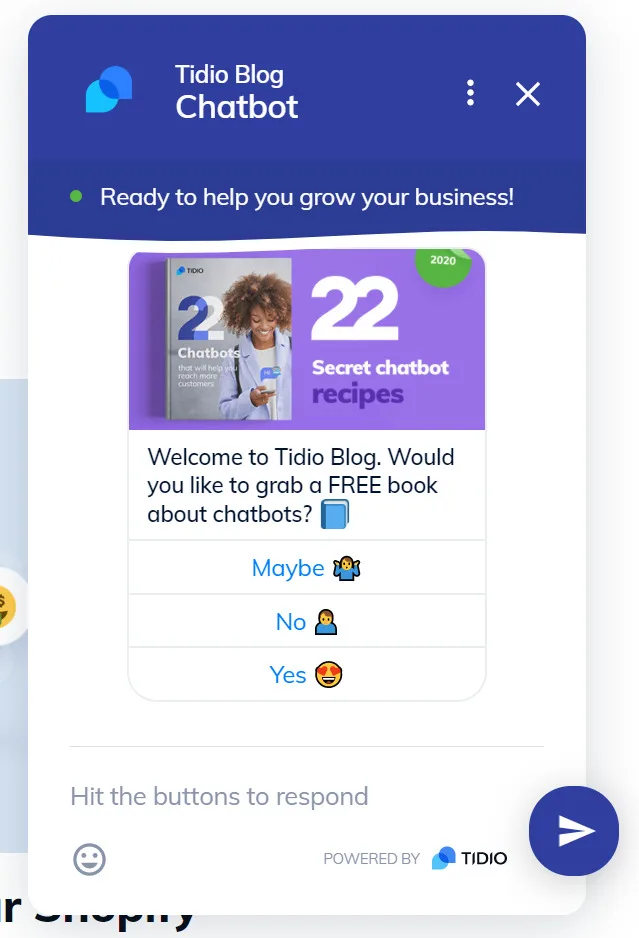
The person seeing this chat in the corner of the website can choose to interact with it. Depending on the chatbot’s script and the user’s intent, the conversation can guide your audience towards becoming a part of your sales funnel — either as leads or new customers.
A great aspect of chatbots is that they are automated and available 24/7. You can also customize the conversation based on various parameters.
Chatbots can serve as a customer service tool answering questions about your product or service or a lead generation and sales tool collecting emails and helping your users go through their buyer’s journey. They are also non-invasive and can be highly personalized to each person interacting with them.
Chatbots can also send targeted messages based on the triggers you set up for them. For example, you can set them up to offer a discount only to first-time visitors.
Furthermore, rapidly developing AI technology will soon enable chatbots to fully take over interactions with your website’s visitors. They will be able to intelligently answer most questions and resolve the issues currently handled by customer service reps.
3. Understand.
The next step is all about really understanding your audience. It comes down to creating customer segments and ensuring that you focus on qualified leads only. Traditionally, this is a process that takes quite a lot of time and effort from your sales team.
You have to build and maintain a relationship with your leads, then set up the right marketing automation system for your email nurturing to qualify them.
With chatbots, this whole process can be done the moment they interact with your website’s visitors for the first time. In fact, qualifying and segmenting your leads can be done in a few ways.
First of all, you can do it by designing a chatbot that requires them to choose one of the given options/answers. For example, our target audience consists of ecommerce businesses. Here’s how we segment them based on the platform where they run their stores.
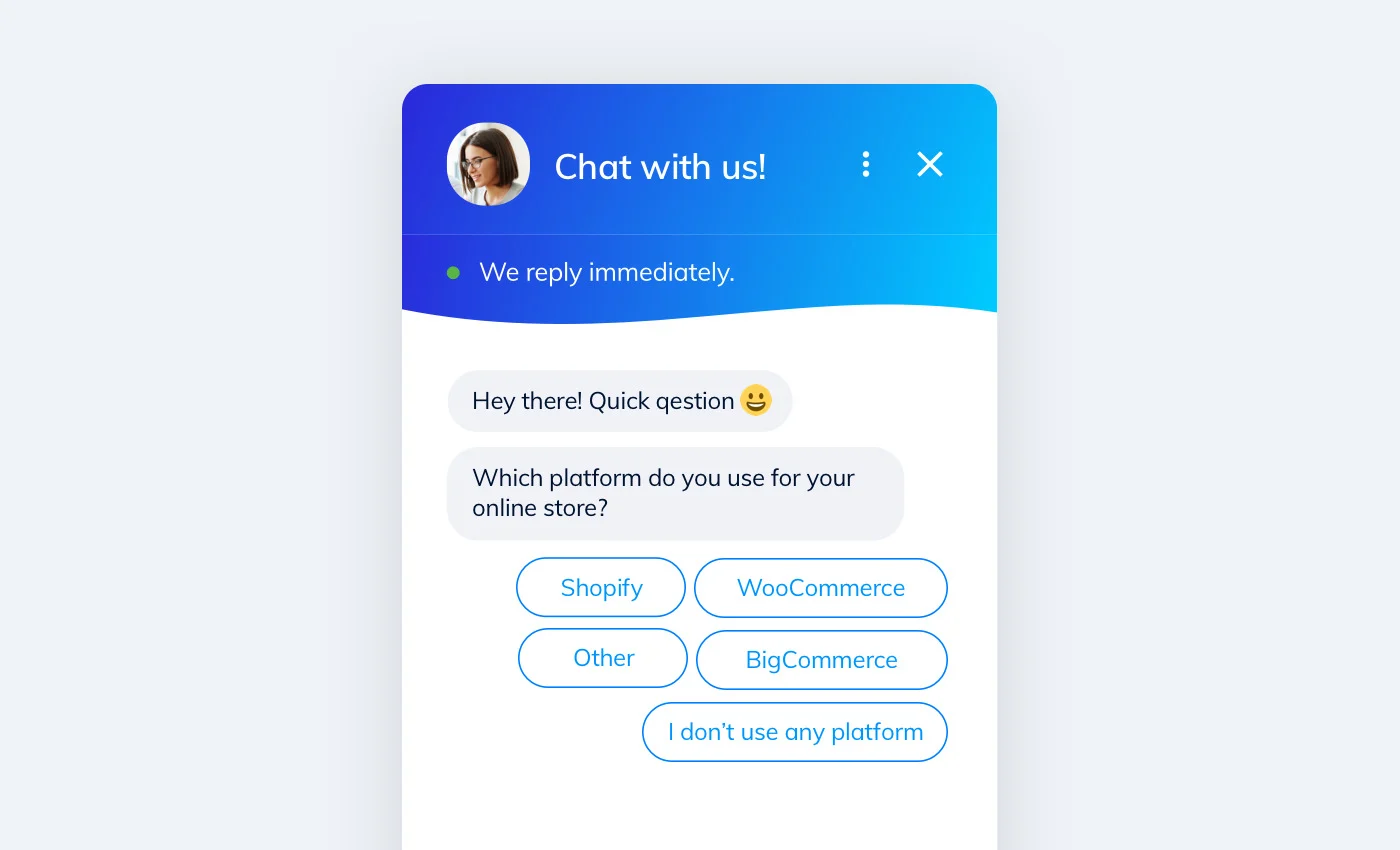
Depending on their answer, we are able to personalize our content and our offer to suit their needs. All you have to do is set up the right script for chatbots asking qualifying questions and collect this data
Additionally, chatbots can automatically monitor the behavior of your website’s visitors without them having to interact with a bot. You don’t need to use fancy analytics tools, because chatbots can segment your audience based on your chosen properties.
These can include:
Geolocation and language.
Visited/viewed pages.
Interaction with customer support.
Browser.
Cart abandonment.
And so on. Here’s an example of the segmentation setup.

Lastly, you can also create so-called conversational landing pages. Using these, your team can connect one-on-one with your prospects and answer their individual questions in real-time using a chatbot or live chat.
Here’s how it can look:
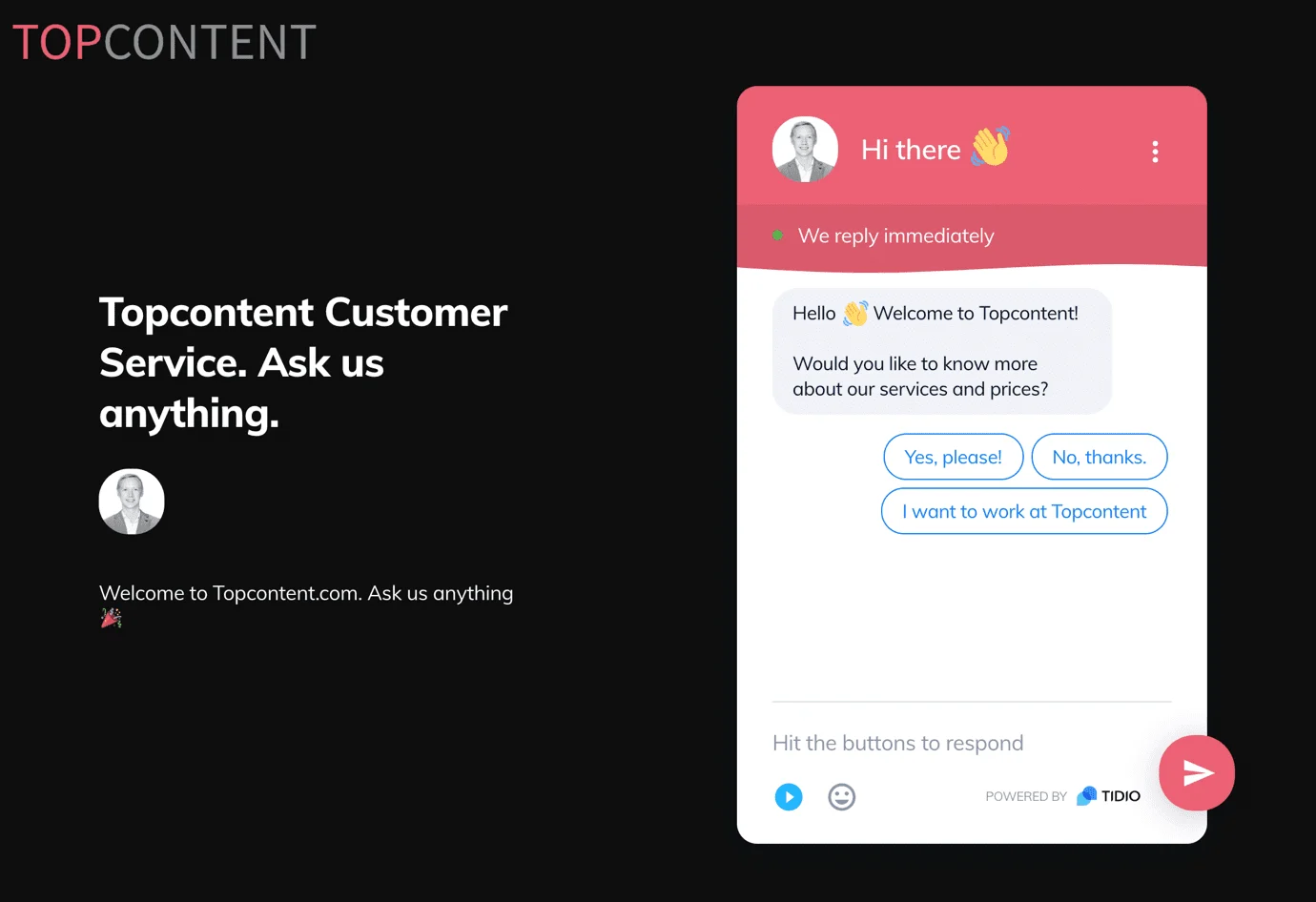
As you can see, conversational marketing using bots and landing pages is a great way to automate your customer communication, personalize it, and use gathered data for future lead nurturing and email campaigns.
4. Recommend.
Lastly, after your chatbot has already engaged with your website’s visitors and collected some data about them, it might be the right time to transfer the matter into human hands. Truth is, bots are great for performing easy, repetitive tasks and getting to know your audience’s preferences, but to move them to the last stage of the funnel — purchase — human interaction might be necessary.
Having gathered all relevant data, your sales team has a much better picture of all customer segments — how they behave and what they expect. This allows your sales rep to further personalize the buyer’s journey and eventually convert your prospects into customers.
One way to do that is to design your chatbot to suggest a call or chat with your sales rep after going through the automatic qualification phase.
To automate the process further, you can integrate your employees’ calendars and simply display a link to book a call. It’s a great solution as it allows for both sides to save tons of time and be fully prepared for the last decision phase of the sales process.
Also, if your chatbots are set up to rescue abandoned shopping carts, it can fire up when the prospect is leaving the site or deleting the items and enquire about reasons for doing so. Apart from gathering data on why this situation took place, it can also help your prospects to troubleshoot their issues (e.g., issues related to the checkout process) and encourage them to complete the transaction
All in all, chatbots can serve as a powerful tool for guiding your audience through their buyer journey. They potentially save your sales team tons of time as well as enable them to move your leads down the funnel using account based marketing approach for bigger deals.
Tips for Using Conversational Marketing Successfully
Now it’s time to look at best practices for putting conversational marketing to work for your business. Here are some tips that helped us and other businesses integrate conversational marketing successfully.
1. Choose the right ecommerce platform.
It’s no news that in order to make conversational marketing a part of your sales process, your store’s platform should enable third-party app integrations without requiring mad coding skills to install chatbots.
Whether you are just starting an ecommerce business or already running it, make sure that technical limits won’t be a problem.
For example, BigCommerce is a popular choice for nearly seamless plugin or app installations.
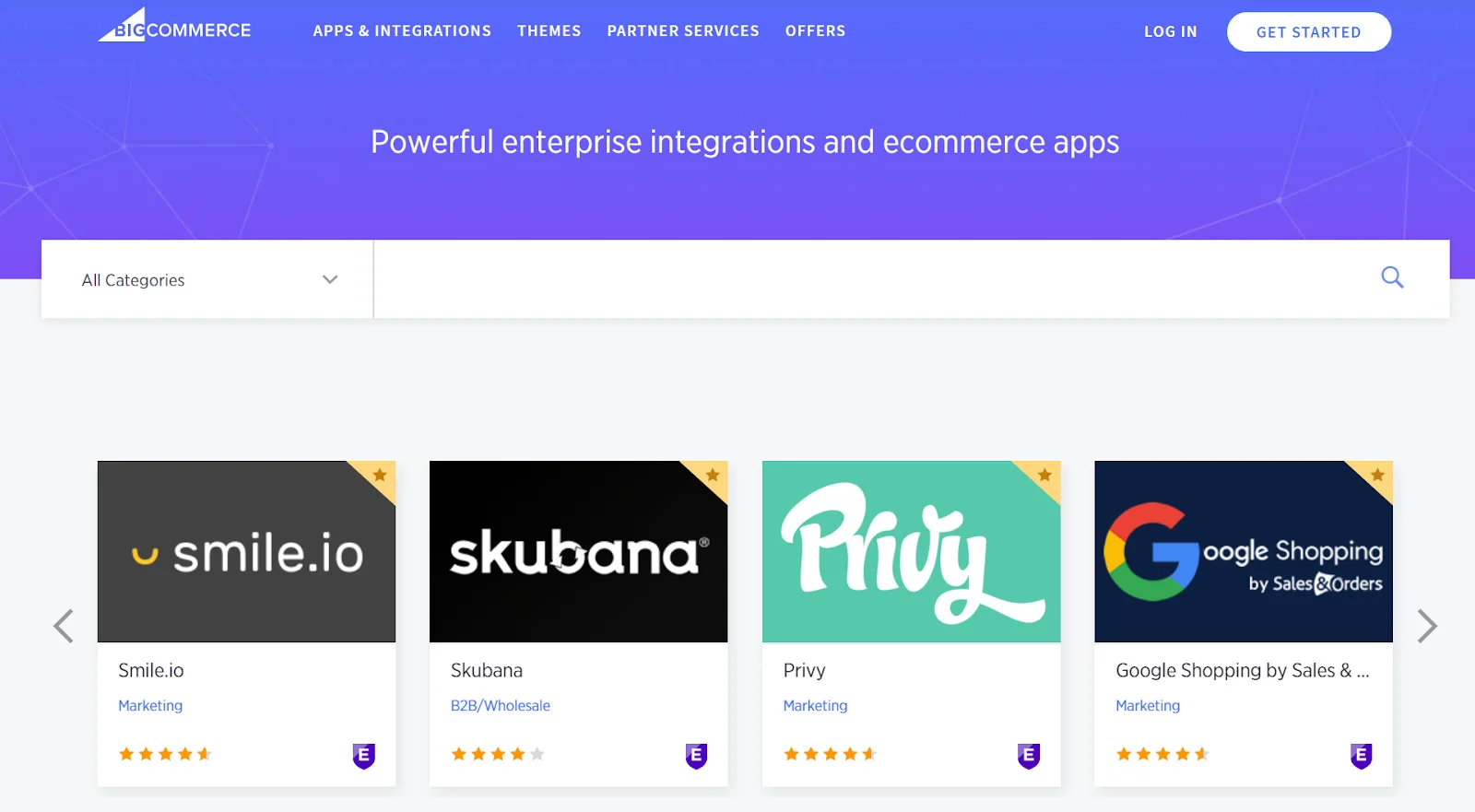
Also, it’s great if you can customize your chatbots in a way that they match your website’s design as it’s helpful in creating a coherent brand recognition.
2. Humanize your chatbots.
The best part about automating processes with chatbots is that they never take days off and they are always in a good mood. Chatbots cannot fully replace human interaction, but they are pretty close to making it as convenient and enjoyable for the user as humans do
This is, of course, only if you design them to be user-friendly and to resemble a real human conversation. It’s crucial to humanize your chatbots as much as possible for your website’s visitors to be willing to engage with them
At the end of the day, their personal experience with your chatbots should be equally or more satisfying than an interaction with your team’s members.
Chatbots can be funny, interesting, informative, or all of the above. If you go for the scripted chatbots, you should put some effort into designing them in a way that seems natural and friendly for the people interacting with them.
3. Integrate with your email marketing and social media.
As chatbots can gather plenty of data on your website’s visitors’ behavior and segment them based on that data, it’s important you use it to your advantage. Integrate conversational marketing as a part of your marketing channel, including email marketing and social media.
With data collected by chatbots, you can launch personalized email nurture campaigns to convert your leads into paying customers. Gathering detailed customer data on autopilot is one reason why chatbots are such a powerful solution.
Don’t forget to also equip yourself with the right email marketing solution to run your campaigns and make the whole sales process even more integrated.
4. Focus on user and customer experience
When implementing sales conversations in your marketing strategy in the form of chatbots’ interactions, your focus should be on your customers’ journey. The process should be optimized to make their experience as convenient and enjoyable as possible. This is why your UX design plays such a crucial role.
Make sure that your chatbots are not randomly triggered, annoying, asking irrelevant questions, or giving wrong answers. Each chatbot’s script should be neatly designed to guide the person interacting with it and make the customer journey smooth.
5. Monitor and adjust the process.
Lastly, it’s important that you actively monitor the whole process. Conversational marketing is a novel approach, and you might need to experiment quite a bit before you master it.
Don’t give up your traditional lead forms just yet, and remember — you can always find a way to combine multiple marketing approaches for achieving better results.
Review the process regularly, collect your users’ feedback, and make adjustments as you go. Conversational marketing can become a powerful part of your marketing operations, but only if it’s integrated into your existing strategy without causing any friction.
Tools for Conversational Marketing
Of course, I could not leave you without naming a few tools that could help you in implementing conversational marketing into your marketing strategy. Here are a few options that you can test and choose the most suitable one.
1. Tidio.
Tidio is an all-in-one customer engagement platform. It consists of a live chat, chatbots, and a mailing feature that you can use for automating your marketing funnels. Using Tidio you can easily make chatbots for your online store and use them to interact with your website’s visitors, segment and qualify your leads and shorten your sales cycle
2. Drift.
Drift is a conversational marketing platform that allows you to communicate with your audience and helps automate your sales and customer service processes. You can personalize the whole experience and use the tool for improving your buyer’s journey.
3. Intercom.
Intercom is yet another customer engagement tool that you can use for interacting with your website’s visitors in real time. You can set up your bots to answer your audience’s questions, to qualify them, and to set up meetings with your sales reps.
6 Examples of Conversational Marketing Done Well
Let’s take a look at a few awesome examples of how others have successfully implemented conversational marketing programs. These are our customers whose businesses are thriving thanks to chatbots that welcome visitors, collect email addresses, and answer questions.
1. Sun50.
First example is an online store selling sun protection apparel. It’s engaging visitors using chatbots and asking whether they’d be interested in receiving a promotion code. It’s simple and the conversation flow is straight to the point, at the same time it doesn’t disturb the website’s visitor’s journey in any way, as it’s tucked in the right side corner of the page.
2. Aria Glow.
Next, take a look at this lead generating chatbot that offers a discount in exchange for a mailing list sign up. It offers an appealing deal for the website’s visitors and allows the business to easily collect email addresses to later convert leads into paying customers.
The design of the widget is also very skilfully designed to match the website, making the whole experience more integrated.
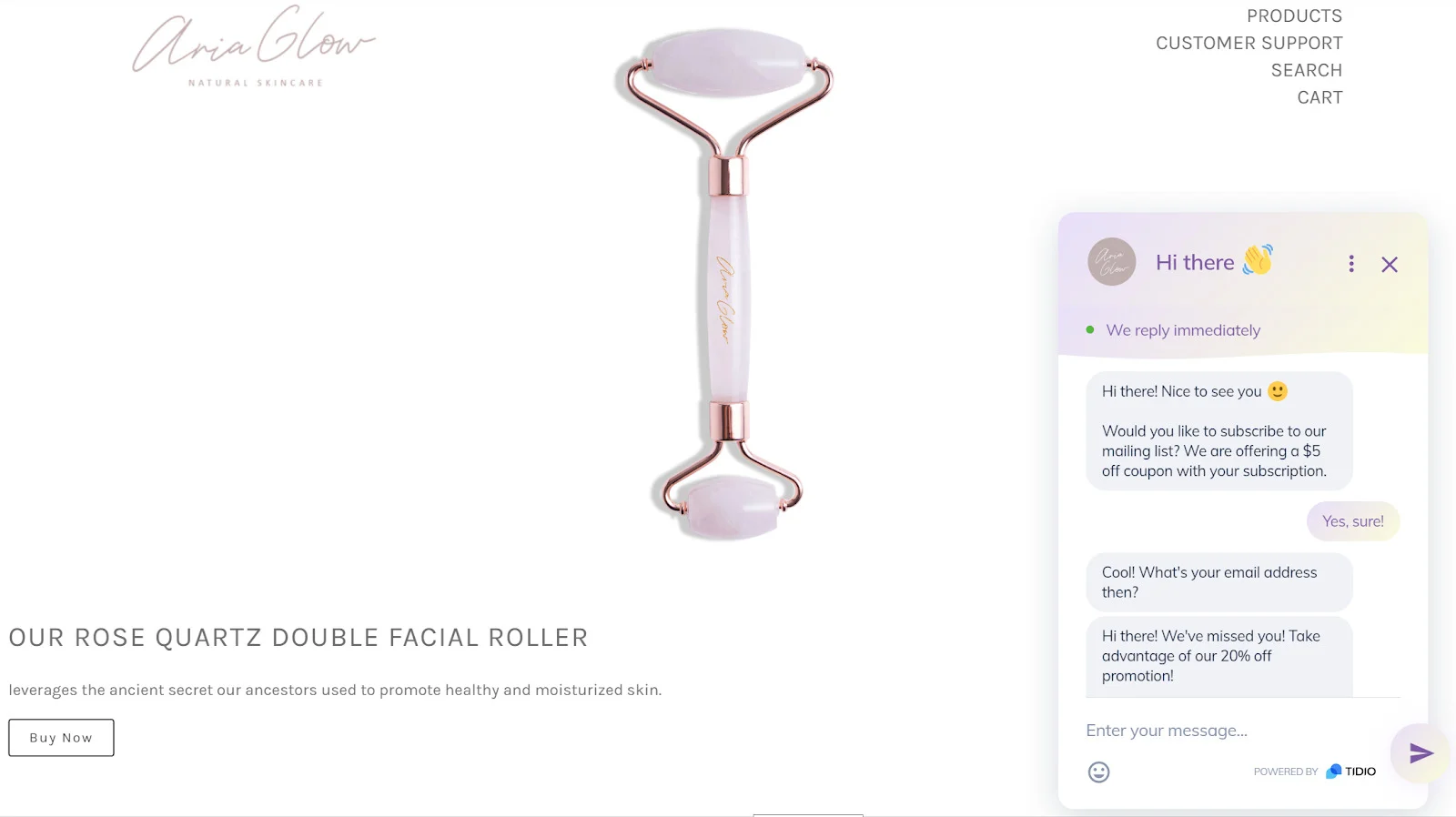
Source: AriaGlow
3. Duobolic.
Here, you can see a simple, non-invasive widget popping up after entering the website. It shows up on the left side of the screen, which is counterintuitive for most people. This way it helps attract immediate attention. The chatbot offers a promo code in exchange for an email address, helping to build your email list. You can later use those collected emails to convert leads into sales.
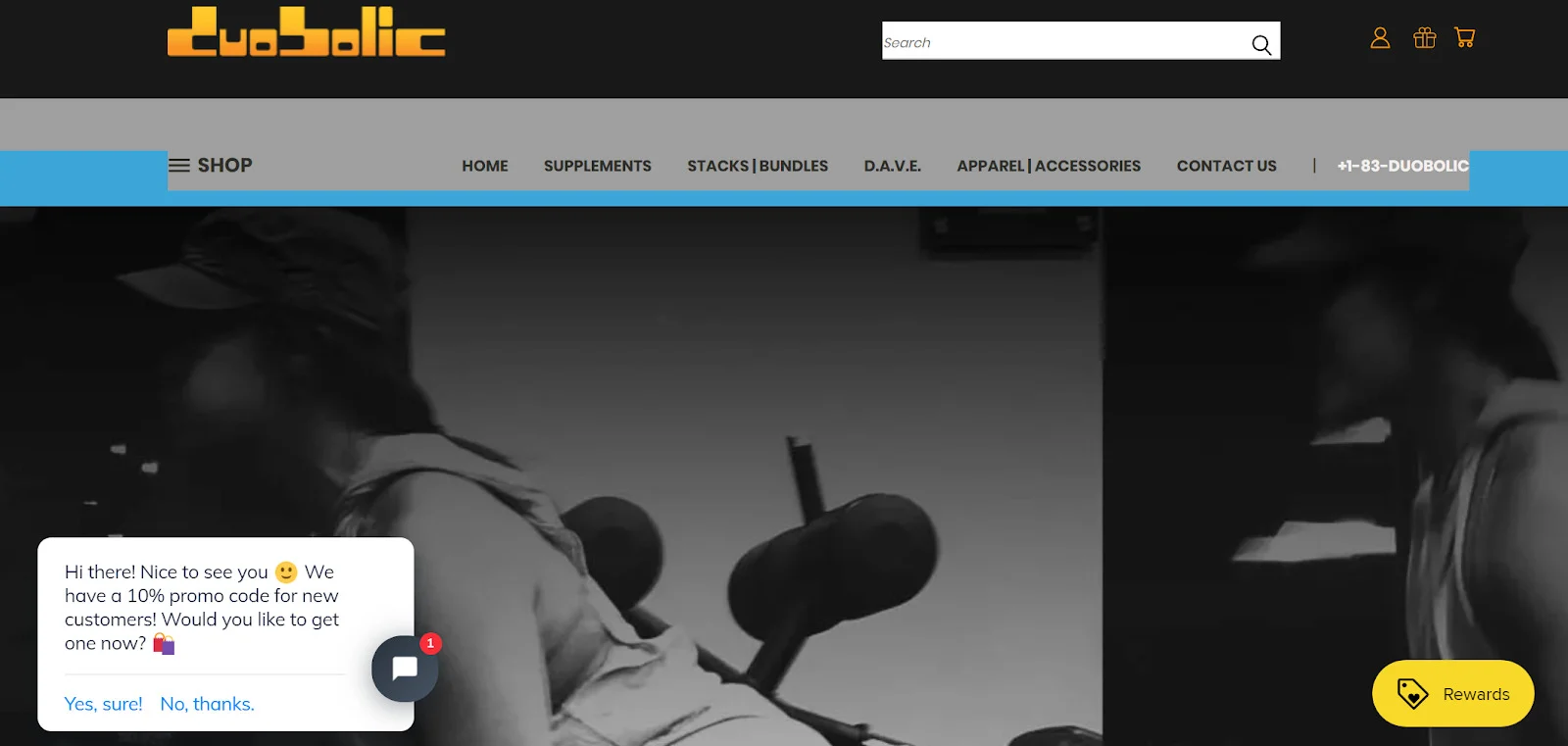
Source: Duobolic
4. AllThingsVinyl.
Here’s an example of a mentioned above separate conversational landing page which enables customer interactions 1:1 with your support or sales team.
It’s a great way for building trust and a close relationship with your target audience as you are able to get to know their needs much better.
Conversational landing pages are especially important for B2B ecommerce where the decision process is longer and often requires building trust before cutting the deal.
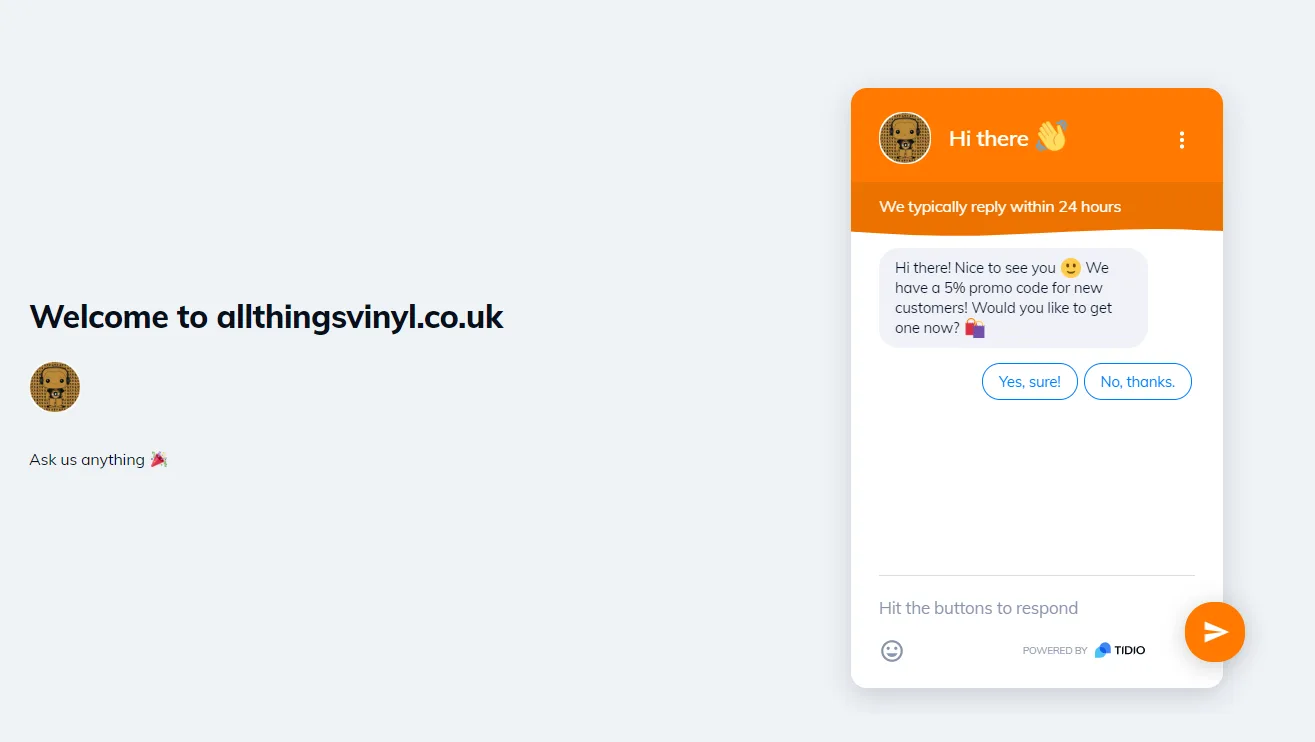
Source: allthingsvinyl.co.uk
5. The Dream Collection Shop.
Another example of conversational marketing in practice is using a Facebook Messenger bot. It’s great for engaging your profile’s visitors and answering most popular queries.
You can design it as a FAQ bot or use it for booking services/appointments. It’s fast to set up and you can also quite easily integrate it with a chat on your website. Here’s how it looks.

Source: The Dream Collection
6. Latex Nemesis.
Lastly, in this example you can see a bot triggered after someone is about to leave the page.
The chatbot tries to stop the visitor with a 10% discount code. It also informs whoever is on the page that the team is currently offline, but a user can leave a message to be replied to later.
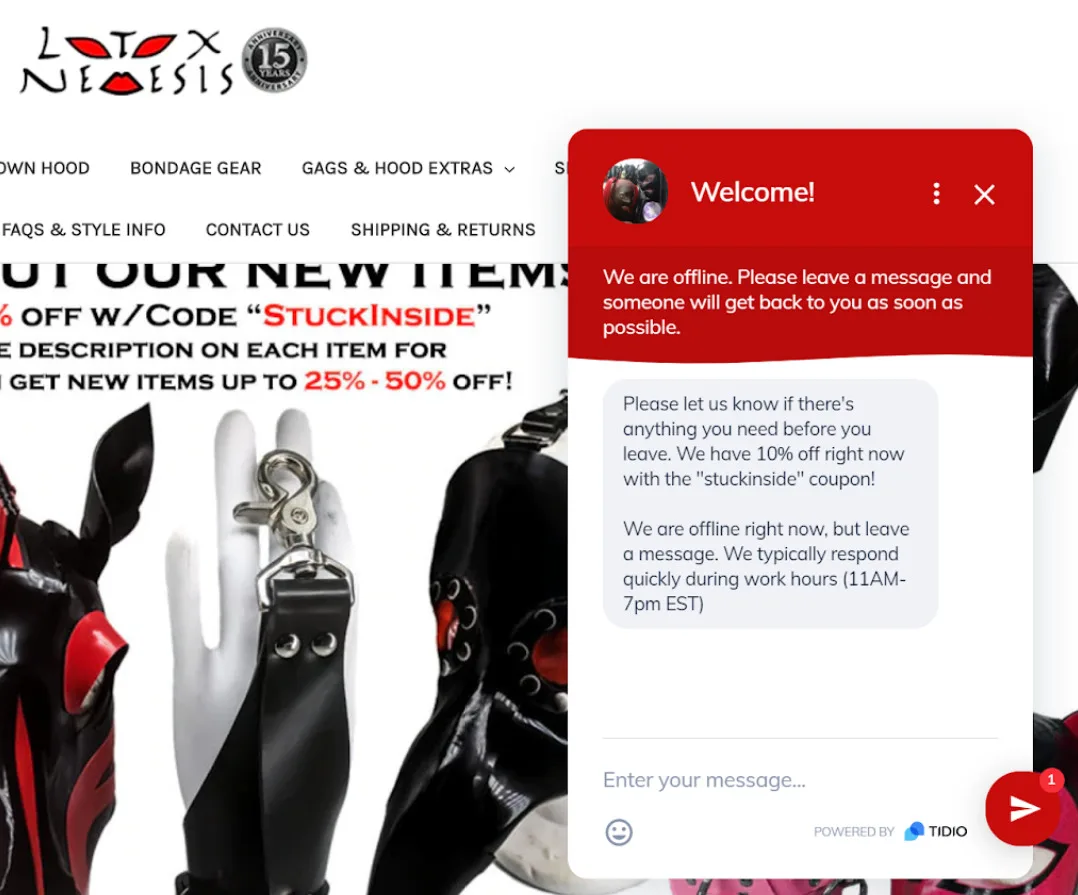
Source: Latex Nemesis
Now that you know how bots can actually look on your website, it’s time to learn how you can measure their effectiveness.
Measuring Your Conversational Marketing Efforts
Lastly, it’s time to learn how you can measure whether your conversational marketing strategy is bringing you the desired outcomes. There are a few key factors that you should closely monitor in order to see if your results are satisfying. This will also give you a good idea about what needs to be improved and adjusted.
1. Increased lead engagement.
Have chatbots helped you engage your website’s visitors and turn them into potential customers?
Well, with more than 41% of consumers seeking assistance when buying online because they can’t find answers to simple questions, there is a big potential for chatbots filling in this gap and engaging website’s visitors.
In order to measure how active your customers are when interacting with your business, you should monitor metrics such as chatbots interactions, the time spent on your website, or a number of collected emails.
It’s likely that people who have interacted with your chatbot or customer support agents (via a live chat or a conversational landing page) trust your brand more and are more active leads (for example signing up for your webinars, etc.) and, eventually, loyal customers.
2. Improved NPS.
The Net Promoter Score (NPS) is quite an important metric that helps you assess loyalty of customers to a company. Using conversational marketing is meant to improve your customer experience, hence show your customers that their needs are your priority.
Monitoring your NPS after introducing conversational marketing to your strategy is crucial. If it’s improved and you are acquiring more loyal and happy customers, it means the solution is working well.
Pay attention to your reviews on popular sites, such as Capterra or G2. Here, at Tidio, we’ve introduced the feedback loop system measuring our NPS and informing us about all new reviews on Slack.
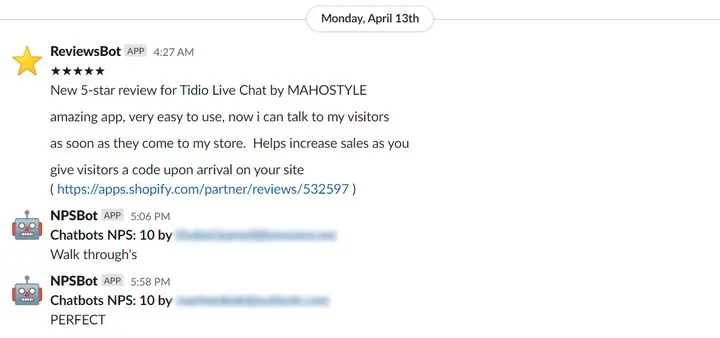
3. Lower customer acquisition cost.
Another metric you should pay attention to is your CAC (customer acquisition cost). You should check your data and find answers to following questions:
Did chatbots allow you to lower CAC?
What’s the CAC before and after implementing conversational marketing?
Have you been able to close more deals thanks to automating your sales process?
Monitoring this factor will allow you to understand how chatbots are contributing to your company’s growth. In some cases, the outcome won’t be obvious — for example, you could have improved your customer support and get more awesome business reviews thanks to more people having heard about your product or service.
Lowering the CAC can also mean being able to scale closing deals with customers who normally need to get in touch with your sales reps or customer support before making a purchase.
4. Shortened sales cycle.
Lastly, using conversational marketing helps you to automate your sales process and shorten the cycle. For example, instead of replying to FAQ related to your pricing or offering in general, your chatbots can provide this information automatically. They can also do the follow up with whoever interacted with them in the past, for example offering a discount to a returning customer.
Conversational marketing using chatbots allows your customer support agents and your sales reps to focus on closing deals that really require human-to-human interaction.
When your website’s visitors can get all the important information about your product or service via chatbot conversation, they can make a purchase decision much faster.
This is why it’s crucial that you compare the time used for closing deals before and after implementing this solution for your business.
Conclusion
We’ve covered the foundation of the conversational marketing approach and explained how you can use it to your business advantage. As this marketing concept is gaining more popularity, it’s important that you don’t miss out on this opportunity.
It’s also a great solution for companies with remote teams of support agents as automated customer service makes it way easier to manage their operations.
Your customers expect for their experience to be personalized to their needs and wants. Conversational marketing is a great way to facilitate that without making big changes to your marketing strategy as a whole. Experiment with it and see how your customers react to it.
Good luck!

Head of Growth at Tidio . Pawel has 10+ years experience in marketing and sales in the IT industry and enjoys sharing his knowledge with others. You can connect with him on Twitter or LinkedIn.